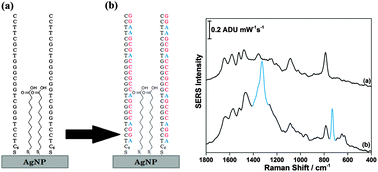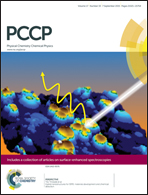Development of an electrochemical surface-enhanced Raman spectroscopy (EC-SERS) aptasensor for direct detection of DNA hybridization†
Abstract
Rapid detection of disease biomarkers at the patient point-of-care is essential to timely and effective treatment. The research described herein focuses on the development of an electrochemical surface-enhanced Raman spectroscopy (EC-SERS) DNA aptasensor capable of direct detection of tuberculosis (TB) DNA. Specifically, a plausible DNA biomarker present in TB patient urine was chosen as the model target for detection. Cost-effective screen printed electrodes (SPEs) modified with silver nanoparticles (AgNP) were used as the aptasensor platform, onto which the aptamer specific for the target DNA was immobilized. Direct detection of the target DNA was demonstrated through the appearance of SERS peaks characteristic for adenine, present only in the target strand. Modulation of the applied potential allowed for a sizeable increase in the observed SERS response and the use of thiol back-filling prevented non-specific adsorption of non-target DNA. To our knowledge, this work represents the first EC-SERS study of an aptasensor for the direct, label-free detection of DNA hybridization. Such a technology paves the way for rapid detection of disease biomarkers at the patient point-of-care.

- This article is part of the themed collection: Surface-enhanced spectroscopies

 Please wait while we load your content...
Please wait while we load your content...